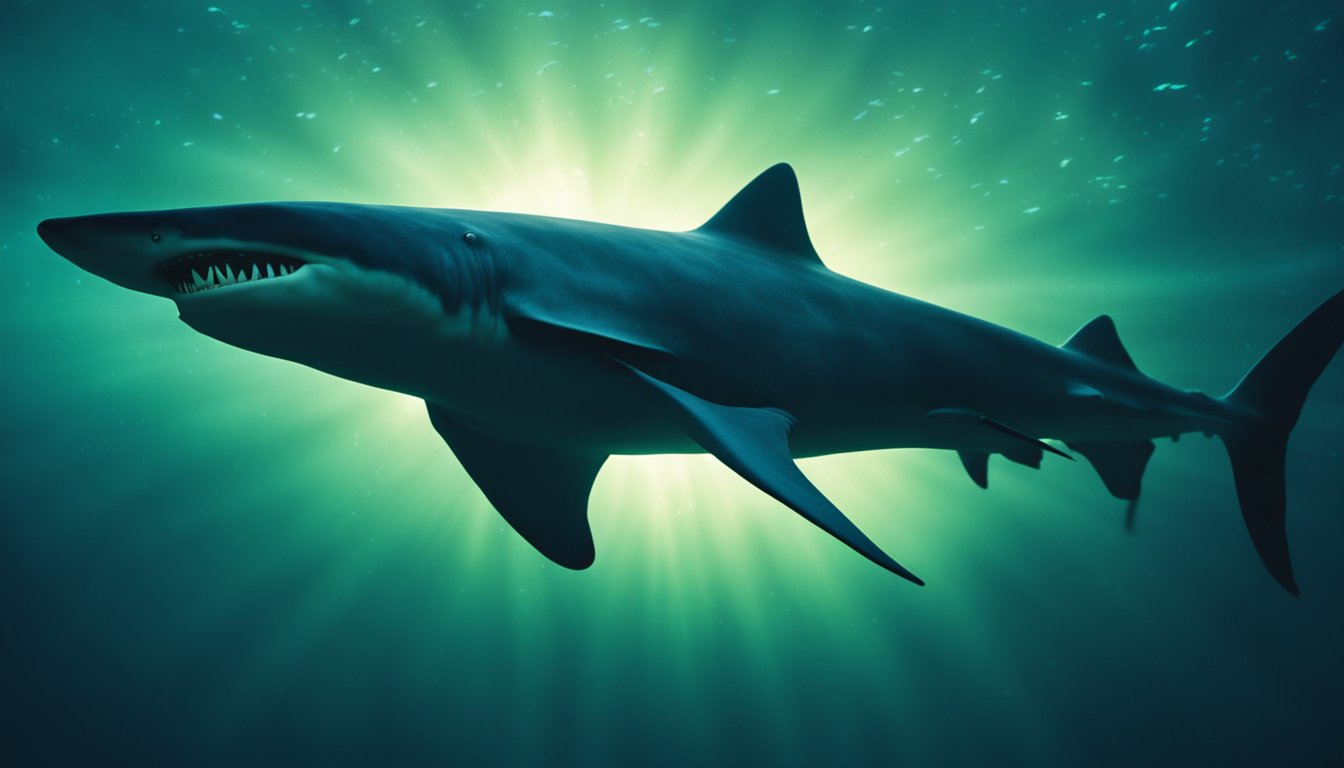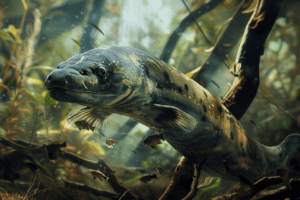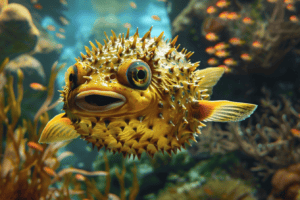The Goblin Shark is a rare and mysterious creature that has fascinated marine biologists and ocean enthusiasts alike for decades.
With its long, protruding snout and needle-like teeth, the Goblin Shark is an enigmatic deep-sea predator that has only been observed a handful of times in the wild.
Journey into the Depths: The Mysteries of the Goblin Shark is an article that explores the fascinating world of this elusive creature, shedding light on its anatomy, behavior, and habitat.

As readers embark on this journey, they will discover the unique adaptations that make the Goblin Shark a formidable predator.
From its extendable jaws to its electroreceptive organs, every aspect of this creature’s anatomy is perfectly suited for life in the deep sea.
They will also learn about the Goblin Shark’s behavior, including its hunting techniques and social interactions, as well as its preferred habitat and distribution around the world.
Through engaging language and relatable analogies, the article aims to educate readers about the Goblin Shark while sparking their curiosity and sense of wonder about the natural world.
With fun facts and statistics woven throughout the text, readers will be encouraged to actively learn and explore the mysteries of the deep sea alongside this fascinating creature.
Unveiling the Goblin Shark
Mysterious Habitat
The Goblin Shark, a rare deep-sea creature, is a mystery to many.
These sharks are typically found in the depths of the ocean, in waters ranging from 100 to 1300 meters deep.
They are most commonly found in the Pacific Ocean, but have also been spotted in the Atlantic and Indian Oceans.
The Goblin Shark’s preferred habitat is the continental slope, which is the steep slope that leads from the continental shelf down to the deep ocean floor.
This area is known to be rich in food sources such as squid, fish, and shrimp.
The Goblin Shark is a solitary creature and is rarely seen by humans due to its remote habitat.
Unique Anatomy
The Goblin Shark is known for its unique appearance, with a long protruding snout and a distinctive pink color.
Its snout, also known as a rostrum, is lined with sharp teeth that it uses to catch prey.
The Goblin Shark’s jaws are also unique, as they can protrude from its mouth to capture prey.
The Goblin Shark is a slow swimmer, but its unique anatomy makes it a formidable predator.
Its long snout allows it to sense electrical impulses from prey, while its protruding jaws can quickly snatch up unsuspecting prey.
The Goblin Shark is also able to rotate its jaws to better grasp its prey, making it a highly adaptable predator.
In conclusion, the Goblin Shark is a fascinating creature that has captured the imagination of many.
Its mysterious habitat and unique anatomy make it a true wonder of the deep sea.
Feeding Habits and Prey

Hunting Techniques
The Goblin Shark is a slow-moving, deep-sea predator that uses its long snout to detect prey.
Its snout is covered in electroreceptor organs that allow it to sense the electric fields produced by other animals.
Once it detects prey, the Goblin Shark uses its powerful jaws to capture it.
Its jaws are capable of extending outwards to grab its prey, making it an effective predator of fish, squid, and crustaceans.
Dietary Preferences
The Goblin Shark has a varied diet and feeds on a range of animals found in the deep sea.
Its diet consists mainly of fish, squid, and crustaceans, but it has been known to eat other sharks and even garbage.
The Goblin Shark is an opportunistic feeder and will eat whatever prey is available to it.
Fun Fact: The Goblin Shark’s jaws can extend up to 8% of its total body length, allowing it to capture prey that is otherwise out of reach.
The Goblin Shark’s unique feeding habits and diet make it an important predator in the deep sea ecosystem.
Despite its intimidating appearance, the Goblin Shark plays a crucial role in maintaining the balance of the ocean’s food chain.
Conservation Status

Threats to Survival
The Goblin Shark is a rare and elusive species that faces several threats to its survival.
The primary threat is overfishing, as Goblin Sharks are often caught as bycatch in commercial fishing nets.
They are also hunted for their fins, which are considered a delicacy in some parts of the world.
Habitat destruction and pollution are also significant threats to Goblin Shark populations.
As deep-sea creatures, they are particularly vulnerable to the effects of climate change, which can alter ocean currents and temperatures.
Protection Efforts
Efforts to protect Goblin Sharks are ongoing, but they face significant challenges due to their elusive nature and deep-sea habitat.
The International Union for Conservation of Nature (IUCN) has listed the Goblin Shark as “Data Deficient” due to a lack of information about their population size and distribution.
However, some countries have implemented measures to protect Goblin Sharks, such as banning their hunting and regulating fishing practices that may harm them.
In addition, scientific research and monitoring programs are essential to understanding the Goblin Shark’s ecology and behavior, which can inform conservation efforts.
Public education and awareness campaigns can also help to raise awareness about the importance of protecting these mysterious creatures and their habitats.
Overall, protecting the Goblin Shark requires a collaborative effort between governments, conservation organizations, and the public.
By working together, we can ensure that this fascinating species continues to thrive in the depths of the ocean for generations to come.
Fun Fact: Goblin Sharks have a unique protrusible jaw that can extend up to 8% of their total body length, allowing them to catch prey that would otherwise be out of reach.
Human Interactions

Research and Study
The Goblin Shark is a rare and elusive species, making it difficult for researchers to study their behavior and interactions with humans.
However, there have been a few documented incidents of Goblin Sharks being caught accidentally in fishing nets or hooks, providing scientists with the opportunity to study them up close.
Through these studies, researchers have discovered that Goblin Sharks are not aggressive towards humans and are generally harmless.
They tend to avoid contact and will only attack if provoked or threatened.
Because of their deep-sea habitat, Goblin Sharks rarely come into contact with humans, making them a relatively low-risk species.
Cultural Significance
Despite their rarity and lack of human interaction, Goblin Sharks have captured the imagination of people around the world.
They have been featured in popular culture, including movies and television shows, and are often depicted as fearsome predators.
In Japanese culture, the Goblin Shark is known as “tengu-zame,” or “long-nosed goblin shark,” and is considered a symbol of good luck and longevity.
In some parts of Japan, the teeth of the Goblin Shark are used in traditional medicine to treat a variety of ailments.
Overall, while the Goblin Shark may not have a significant impact on human life, it remains an intriguing and mysterious species that continues to fascinate and captivate people of all ages.
Frequently Asked Questions

What unique features set the goblin shark apart from other shark species?
The goblin shark is a unique species of shark with several distinctive features that set it apart from other shark species.
Its most striking feature is its long and protruding snout, which is covered in specialized sensory organs that help it detect prey in the dark depths of the ocean.
The goblin shark also has a highly flexible jaw that can protrude outwards to capture prey.
Finally, its skin is a pale pink color, making it easily distinguishable from other sharks.
Can you explain the diet and hunting techniques of the goblin shark?
The goblin shark is a deep-sea predator that feeds primarily on fish, squid, and crustaceans.
It uses its long snout to detect the electrical signals given off by its prey, and then uses its highly flexible jaw to capture and consume its meal.
Because it lives in the deep ocean, the goblin shark is an ambush predator that waits patiently for its prey to come within range before striking.
How does the goblin shark’s appearance contribute to its nickname ‘living fossil’?
The goblin shark’s appearance has earned it the nickname ‘living fossil’ because it has remained relatively unchanged for millions of years.
Its long, protruding snout and pale pink skin are thought to be adaptations to its deep-sea habitat, where light is scarce and prey is hard to come by.
These unique features have allowed the goblin shark to survive and thrive in the deep ocean for millions of years.
Where in the ocean can goblin sharks typically be found?
Goblin sharks are typically found in deep waters around the world, including the Atlantic, Pacific, and Indian Oceans.
They are most commonly found at depths of 1000-1300 meters, but have been known to swim as deep as 3000 meters.
Because of their deep-sea habitat, goblin sharks are rarely seen by humans and remain one of the ocean’s most mysterious creatures.
What adaptations help the goblin shark survive in its deep-sea habitat?
The goblin shark has several adaptations that help it survive in its deep-sea habitat.
Its long, protruding snout is covered in specialized sensory organs that allow it to detect prey in the dark depths of the ocean.
Its highly flexible jaw allows it to capture and consume prey with ease.
Finally, its pale pink skin is thought to help it blend in with the faint light that filters down from the surface of the ocean.
How do scientists study goblin sharks despite their elusive nature?
Because goblin sharks are so elusive, studying them is a challenge for scientists.
However, scientists have developed several techniques for studying these mysterious creatures.
One method is to use deep-sea submersibles to observe goblin sharks in their natural habitat.
Another method is to study goblin shark specimens that have been caught by fishermen.
By examining these specimens, scientists can learn more about the biology and behavior of the goblin shark.









